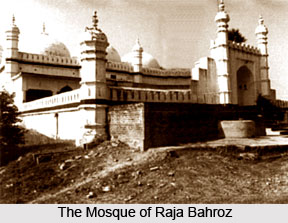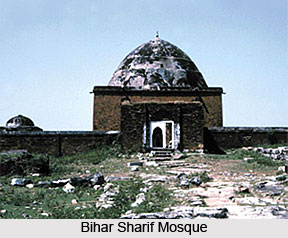 When still a young prince, Shah Jahan had rebelled against his father and Mughal emperor Jahangir in 1623, which is intimately associated with his consequent architecture in Bihar. Eventually, Shah Jahan is also known to have taken Burdwan in Bengal and then had established a counter-court in Rajmahal (in Bihar). Subsequently, Shah Jahan had spent time at Rohtas, where his son Murad Bakhsh was born. After his accession in 1628, however, Shah Jahan never had returned to the eastern hinterlands, with reason not known to the modern world. Instead, powerful and effective agents such as his son Prince Shah Shuja, Shaista Khan and Saif Khan were entrusted with their administration in Bihar and other parts of eastern India.
When still a young prince, Shah Jahan had rebelled against his father and Mughal emperor Jahangir in 1623, which is intimately associated with his consequent architecture in Bihar. Eventually, Shah Jahan is also known to have taken Burdwan in Bengal and then had established a counter-court in Rajmahal (in Bihar). Subsequently, Shah Jahan had spent time at Rohtas, where his son Murad Bakhsh was born. After his accession in 1628, however, Shah Jahan never had returned to the eastern hinterlands, with reason not known to the modern world. Instead, powerful and effective agents such as his son Prince Shah Shuja, Shaista Khan and Saif Khan were entrusted with their administration in Bihar and other parts of eastern India.
During Shah Jahan`s reign, Patna had remained the primary city in Bihar Province. Saif Khan - governor there from 1628 until 1632, had performed much to enhance the city, paralleling his earlier largess when he was Jahangir`s governor of Gujarat. To mention some of the meritorious instances of Bihar`s architecture during Shah Jahan, Saif Khan indeed acknowledged to have built grand mansions, though they no longer survive and at least two religious structures. One is an Idgah that he had provided in 1628, his first year as governor of Bihar. The central bay of its qibla wall, the only wall of this Idgah, is higher than the successively lower flanking ones. It contains a deeply recessed tri-partite mihrab whose demi-dome is marked by netted vaulting. Each side of the wall of this unusual Idgah possesses an intermeshed octagonal turret. This feature, witnessed earlier in Mughal architecture of Bihar and Bengal, such as Farid Bukhari`s Bihar Sharif mosque and the Hajipur Jami mosque, is derived from the region`s pre-Mughal Islamic buildings. This is yet another aspect that architecture in Bihar during Shah Jahan, or for that matter under any Mughal, was very much interlinked with pre-Mughali attempts in eastern parts of the country, a feature which is highly unlikely in Mughal architecture in Delhi or Agra.
Saif Khan also had provided a theological school (madrasa) to Bihar`s architecture under Shah Jahan, on the banks of the Ganges. Originally erected to house more than a hundred students, the madrasa complex was lined with large vaulted buildings, including a hammam. On the north side, overlooking the Ganges, are chattris to provide soothing shade. Next to the mosque on the west - yet another stellar presence of religious instance in eastern India`s architecture in Bihar during Shah Jahan, was a large double-storeyed entrance portal that Mundy describes as being `stately`. Despite its date of 1629, the mosque was still not accomplished in 1632, Mundy observed, although he indicates it was nevertheless in use. Foreign traders, for a fee, are known to have used the school for lodging.
 Several mosques were constructed during this time along Patna`s main city street paralleling the Ganges, though only a few still remain. The best preserved instance of a mosque during Shah Jahan`s Mughal architecture in Bihar, is the masjid of Hajji Tatar. Exquisitely carved black stone frames the three arched entryways on the east façade. Such black stone was employed at times on Mughal structures in Bihar and Bengal, but was commonly found on the mosques of Bengal before Mughal times. It was never employed on structures outside the periphery of eastern India. The arched niches flanking the entrances of Hajji Tatar mosque and the facade`s ribbed engaged columns are typical of mid-seventeenth-century buildings in eastern India, for example on Habib Khan Sur`s mosque, built in 1638 at nearby Bihar Sharif. The mosque`s affiliations with local buildings are thus evident, despite its overall conformity with the prevailing Mughal aesthetic.
Several mosques were constructed during this time along Patna`s main city street paralleling the Ganges, though only a few still remain. The best preserved instance of a mosque during Shah Jahan`s Mughal architecture in Bihar, is the masjid of Hajji Tatar. Exquisitely carved black stone frames the three arched entryways on the east façade. Such black stone was employed at times on Mughal structures in Bihar and Bengal, but was commonly found on the mosques of Bengal before Mughal times. It was never employed on structures outside the periphery of eastern India. The arched niches flanking the entrances of Hajji Tatar mosque and the facade`s ribbed engaged columns are typical of mid-seventeenth-century buildings in eastern India, for example on Habib Khan Sur`s mosque, built in 1638 at nearby Bihar Sharif. The mosque`s affiliations with local buildings are thus evident, despite its overall conformity with the prevailing Mughal aesthetic.
Habib Khan Sur had held a position of great responsibility in Bihar and its architecture during Shah Jahah, especially during the frequent absences of the governor Saif Khan. Habib Khan had provided several works in Bihar Sharif, all in proximity to the dargah of Sharaf ud-Din Maneri (d. 1381) - one of the subcontinent`s most esteemed sufi saints. Amongst these is a refined mosque, dated 1638. This single-aisled three-domed mosque is modelled closely on Shaikh Farid Bukhari`s nearby Jahangiri-period mosque. It was thus almost certainly the product of a local, but expert architect. Several years later, in 1646, Habib Khan Sur had constructed a tank and Idgah near the shrine of saint Sharaf ud-Din. The Idgah though was crudely constructed, revealing none of the refinements of the patron`s earlier mosque, suggesting he had little role in its design.
 Yet another structure influenced by those in Bihar Sharif, within the purview architecture in Bihar under Shah Jahan and his patronised men, is the mosque Raja Bahroz had constructed in Kharagpur in 1656-57. Kharagpur, today in Munger District, long had been the seat of a prominent Hindu family in Bihar. Although initially allied with the Mughals, the Kharagpur rajas were defeated by them during the late 16th century. One member of the family had acknowledged Mughal authority and had also converted to Islam. He was then reinstated on the Kharagpur throne. There, his successors had erected several mosques and many more tombs, suggesting that the newly converted Kharagpur rajas consciously had attempted to create a seat that very much had proclaimed their new religious affiliation.
Yet another structure influenced by those in Bihar Sharif, within the purview architecture in Bihar under Shah Jahan and his patronised men, is the mosque Raja Bahroz had constructed in Kharagpur in 1656-57. Kharagpur, today in Munger District, long had been the seat of a prominent Hindu family in Bihar. Although initially allied with the Mughals, the Kharagpur rajas were defeated by them during the late 16th century. One member of the family had acknowledged Mughal authority and had also converted to Islam. He was then reinstated on the Kharagpur throne. There, his successors had erected several mosques and many more tombs, suggesting that the newly converted Kharagpur rajas consciously had attempted to create a seat that very much had proclaimed their new religious affiliation.
The most magnificent amongst these Hindu-converted-Islam religious architecture by the Kharagpur rajas is Raja Bahroz`s single-aisled three-domed mosque. Situated just north of the raja`s palace on the bank of the river Man, the mosque is elevated on a high plinth - an increasingly common feature of later Mughal mosques. Visible from a great distance, this imposing mosque is the largest one built in eastern India since Raja Man Singh`s Jami mosque of c. 1600 in Rajmahal. The facade of Raja Bahroz`s mosque, now obscured by a modern veranda, had adhered closely to the form of contemporary mosques in Bihar Sharif. Due to the exceeding sanctity held by Bihar Sharif, those mosques doubtless were known to the converted Kharagpur family. Yet, as if to outshine the mosques of this esteemed city and architecture in Bihar during Shah Jahan`s patronage, Raja Bahroz`s instance is even more elegantly ornamented than the ones that serve as its models. Its polychromed stucco relief is more bountiful and copious than the ornamentation of any other contemporary Mughal structure in eastern India.
The tomb of Malik Wisal in Bihar is a simple and humble structure, consisting of a walled rectangular enclosure entered on the north. In the centre of this open courtyard is a raised platform upon which there lies seven graves. A stone-faced wall mosque, punctuated by three mihrabs is attached to its western end. Just outside the tomb can be witnessed a massive step well, rare so far east in India - a sudden dissimilarity in architectural pattern in Bihar under Shah Jahan, a man known to possess capabilities to godlike extent. Since Mughal authorities commonly were transferred from one part of the realm to another, they had indeed served as vehicles for the movement not only of style, but also, as in this case, whole new forms.






































